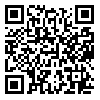BibTeX | RIS | EndNote | Medlars | ProCite | Reference Manager | RefWorks
Send citation to:
URL: http://jdc.tums.ac.ir/article-1-5476-en.html
2- Department of Pathology and Corrective Movements, School of Physical Education, Kharazmi University, Tehran, Iran
3- Department of Medical & Rehabilitation Devices, Janbazan Medical and Engineering Research Center (JMERC), Tehran, Iran
Background and Aim: The aim of present study was to evaluate psychometric properties of the Amputee the Body Image Scale (ABIS).
Methods: A sample of 200 amputee patients were selected from amputee veteran and amputee people under the protection of Red Cerscent by using convenience sampling and asked to respond to the Persian version of The Amputee Body Image Scale (ABIS), Bell Adjustment Inventory (BAI) and Body Areas Satisfaction Scale (BASS). The reliability of the inventory was assessed by internal consistency and item-rest correlations. Also; in order to investigate the validity of the inventory, confirmatory factor analysis, criterion validity and convergent validity were used.
Results: The Cronbach’s alpha (0.89) and item-rest correlations indicated satisfactory reliability of the inventory. The results of confirmatory factor analysis confirmed one factor structure for scale. Also, criterion validity of the scale with the Bell Adjustment Inventory (BAI) and convergent validity of the scale with the Body Areas Satisfaction Scale (BASS) was satisfactory.
Conclusion: The findings showed that the Persian version of the Amputee Body Image Scale is a suitable tool in assessing of body image in amputee patients and can be used in research and intervention fields in Iranian patients.
Received: 2020/12/29 | Accepted: 2020/10/31 | Published: 2020/10/31
| Rights and permissions | |
 |
This work is licensed under a Creative Commons Attribution-NonCommercial 4.0 International License. |





